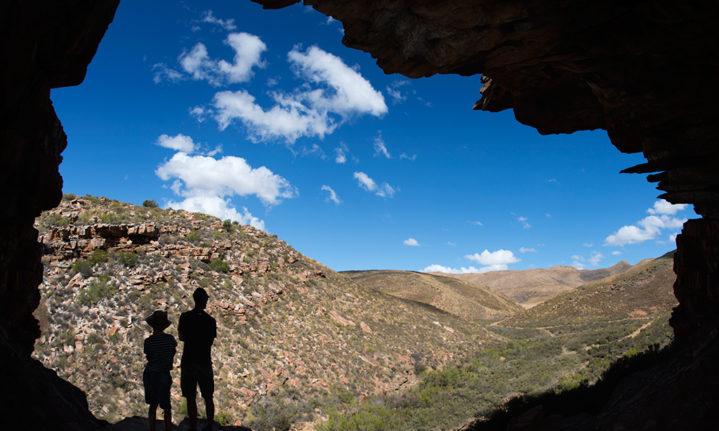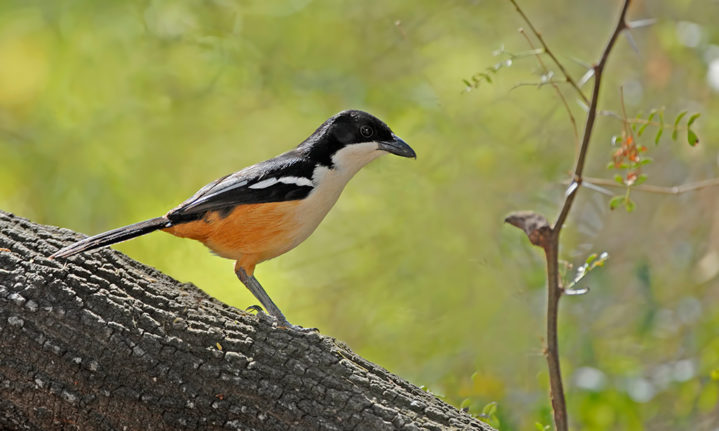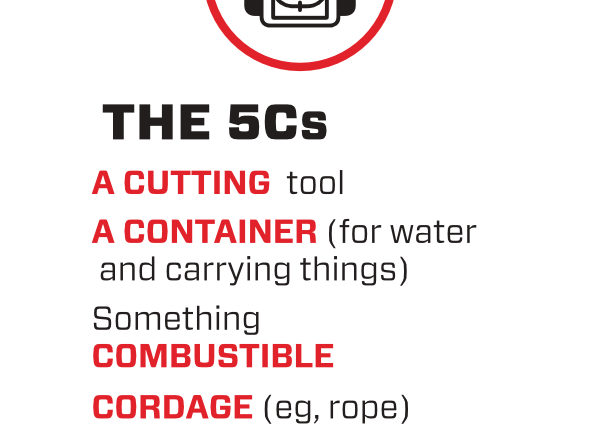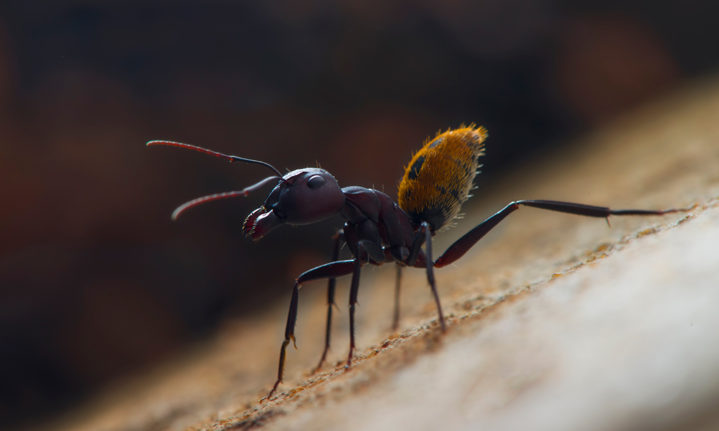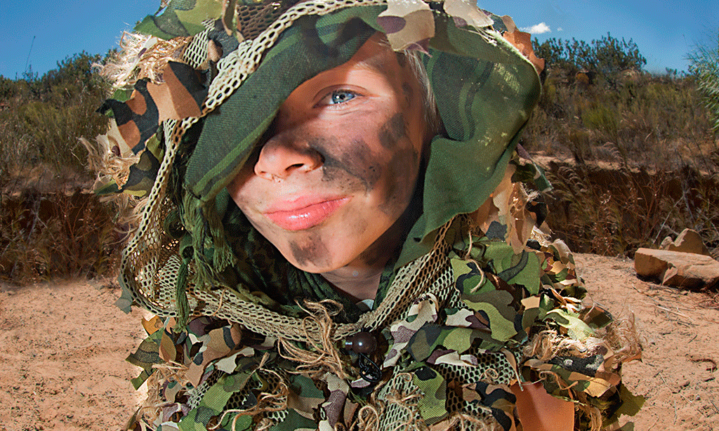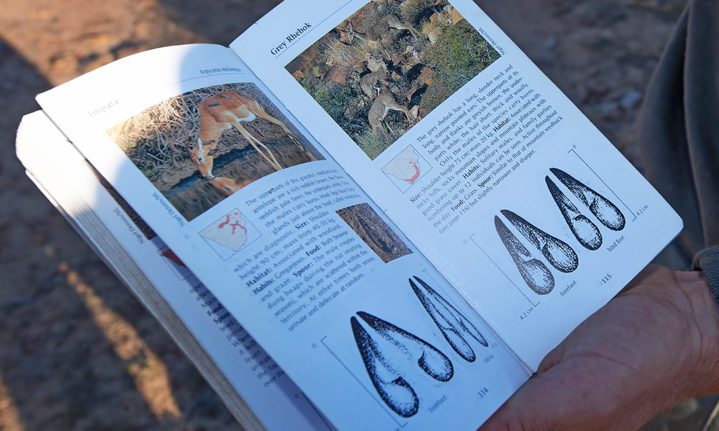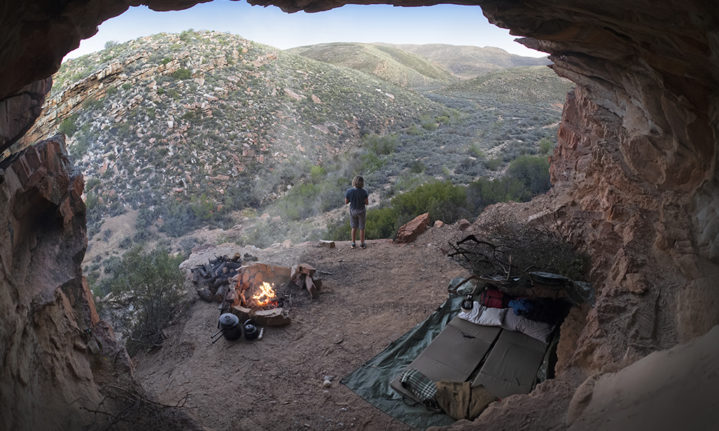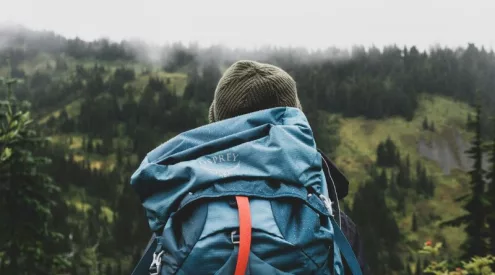Dale R Morris conjures a scenario of doom to convince his family that a bushcraft and survival course is just the vacation they need.
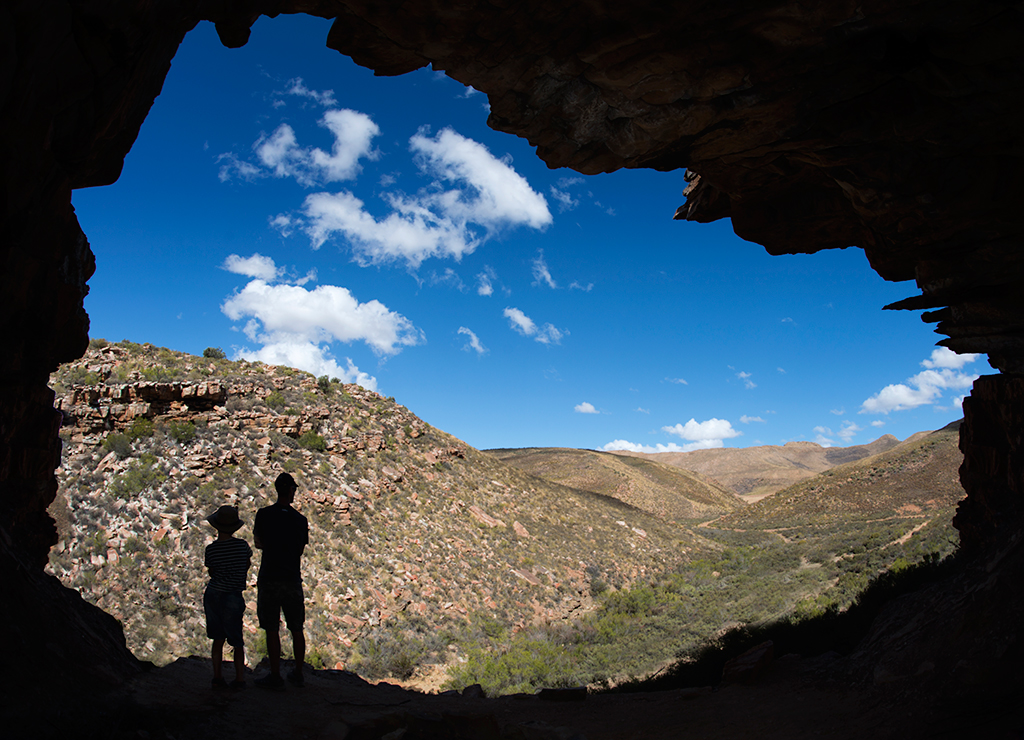
Surviving on the land often means finding and utilising what is available locally. A cave makes a perfect shelter from the worst of nature’s elements.
I was driving home through the crowded, claustrophobic city when I spotted a somewhat dishevelled fellow with an unkempt beard bobbing up and down and weaving between the busy traffic.
His eyes had that manic look of the clinically insane (or recently woke) and his cardboard sandwich board sported the words “The End Is Nigh!” Clearly, he was a deranged fruitcake, but as I paused at the traffic lights, praying he wouldn’t see me, I noted the pavement pedestrians in their protective masks, I smelt the fumes from a thousand exhausts, and I listened to the newsreader’s voice on my car radio as she outlined the woes of the week.
“Climate change. Population growth. Conspiracies. Bigotry. Viruses. Wars. Extinctions. Politicians. K-pop.” The list seemed endless.
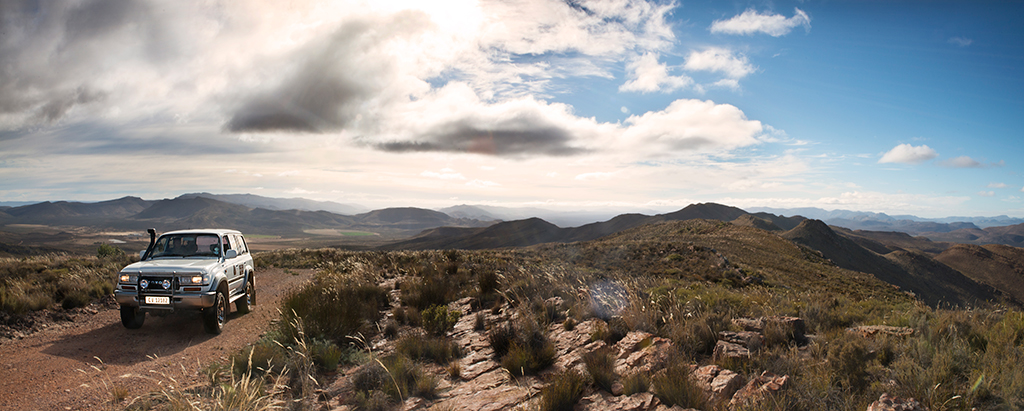
The Western Cape Karoo is a perfect place to learn and hone your survival skills.
Perhaps the man was right. Perhaps the end was nigh. And all of a sudden I had an epiphany. There’s an apocalypse on the horizon! What form it’ll take, I wasn’t sure. Maybe zombies will rise alongside sea levels. Maybe Ebola 2.1 will emanate from a fast food fruit bat franchise and go airborne, or worse, Kanye West will become US president and have access to those big red buttons.
Who knows (except Attenborough – I think he knows) but there was one thing I was completely sure of: neither I nor my family were even remotely prepared to survive this upcoming cataclysm.
Of course, the first thing one must do during Armageddon is to get the heck out of Dodge. Urban folk go crazy and cannot be trusted during an apocalypse. I’ve seen it on the Netflix dramas. Society breaks down within minutes and we all go mad and start eating each other.

A group of young boys enjoying a weekend bush skills course with Geoffrey Phipps
So assuming I make it out into the bush in time to avoid the initial collapse of humanity, where should I forage or hunt for food? How do you protect yourself against the elements? And as for fire, drinking water, shelter, and defence against the office workers who have now become marauders and cannibals?
I was coming up blank. So I conjured up a scenario and ran with it.
‘Children. We have to leave now! SARS is coming for us.’ And without so much as a minute to pack a bag, we escaped into the Karoo with little more than the shirts on our backs. ‘What’s SARS?’ whimpered my kids as we drove unseen through the night along dusty back roads.
‘Unrelenting evil, children. Pure, unstoppable and merciless.’ They seemed afraid.
As well they should be.
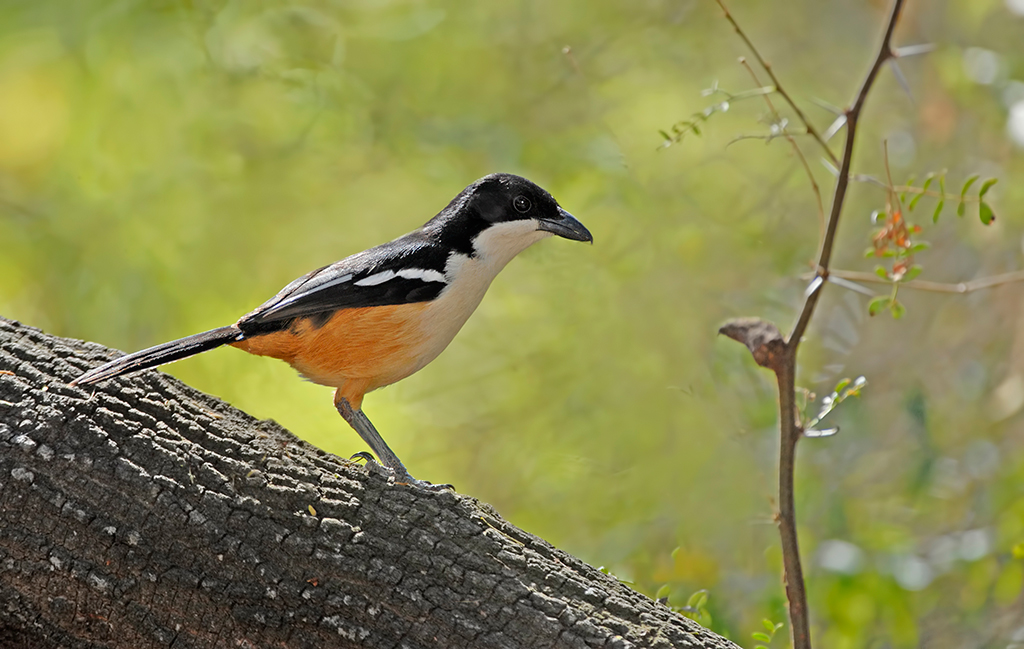
Learn to listen. Wild animals such as birds may give alarm calls when there are predators nearby. If you’re hunting, they’ll tell your prey, and give the game away.
Our destination was the remote Rangers Reserve, a private piece of rolling Karoo situated fairly close to the small Western Cape town of Touws River. Here, you can book a weekend bush survival course with resident experts Geoffrey Phipps and his father in law, Marcus Hargreaves, both of whom are authorities in the art of bush craft, tracking and anti-poaching. Hence our training began.
The first important survival philosophy Geoff introduced us to was the concept of the 5 Cs.
‘These are the things you should have with you when you go to the bush.’ A Cutting tool. A Container (for water and carrying things). Something Combustible. Cordage (eg, rope) and last, but not least, a Cover of some sort to keep you safe from the elements.
‘How many of these did you bring?’ he inquired as we sat around a campfire. ‘I did pack a Cabernet Sauvignon… and Coffee.’ Alas, according to Geoff, these were not the Cs we needed. I begged to differ.
‘Not to worry,’ he told us as the Karoo sun climbed over surrounding hills, bathing them in a beautiful orange warmth. ‘All of these things can be found or made in nature.’

Jackals heralded the day, singing their tuneless ballads, and sunbirds flitted like thrumming bumblebees between protea bushes and acacia thorn trees. There was no sound of traffic; not even a contrail in the sky. Perfect for our family doomsday fantasy.
‘So, who can tell me why a knife is important?’ asked Geoff. Of course, I assumed it was primarily for dispatching zombies or alien invaders, but my daughter had a more down-to-earth response. ‘For cutting. For defence. And for cake.’
‘Mostly correct,’ said Geoff. But seeing as we hadn’t brought, well anything really, our expert mentors took it upon themselves to show us how to fashion a cutting implement from stone and flint: just as our ancestors had done back when they were hunting unicorns and mammoths.
A short stroll down a dry river bed produced some nice looking pebbles which, in the right hands, would have been perfect for creating razors and spearheads, as well as axes.
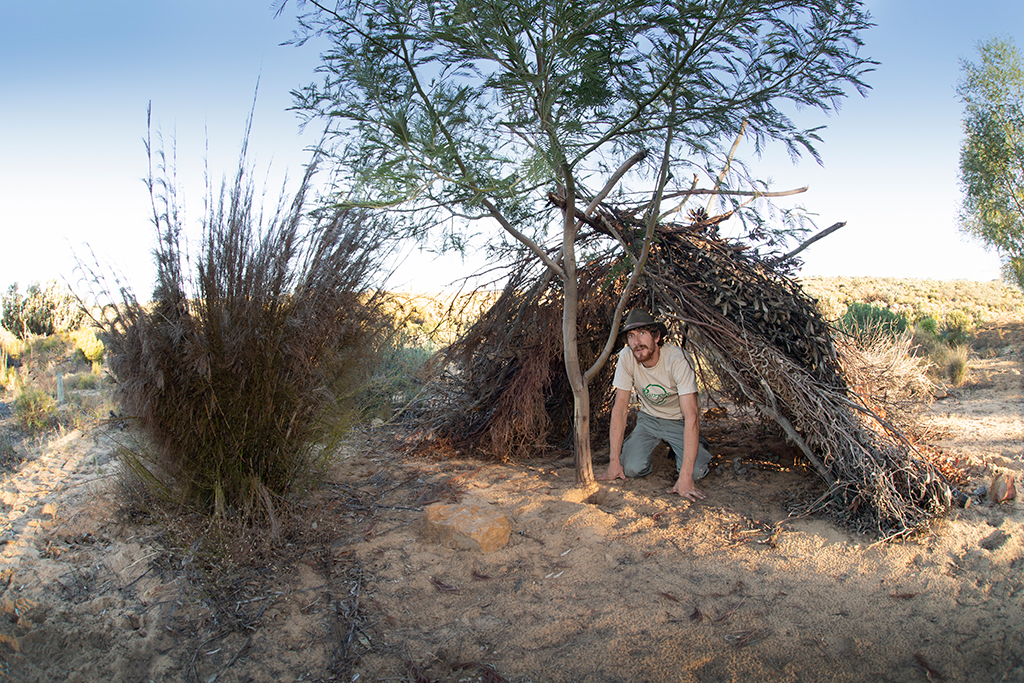
Geoff Phipps is a professional tracker and anti-poaching expert. He’ll teach you how to survive and make the most of what nature has on offer
However, ours were not the right hands, and our initial attempts at bashing out something useful resulted in little more than blasphemy and bruises. ‘It takes a great deal of practice and precision to become proficient at knapping,’ said Marcus, but after some additional hours of patient tutelage, we at least were able to create some sharpened and serrated edges.
Geoff and Marcus made light of our failures and frustrations and praised our tiny successes, making jokes and putting smiles on our faces.
‘Keep those spirits up and make every task as fun as you can,’ we were told. ‘Those who have a level head and remain upbeat will almost always do better in survival situations than a pessimist.’
So that’s why Bear Grylls is always smiling… even when drinking his own pee.

What can you eat and what can’t you eat? Termites are full of protein (and taste like peanuts). Ants are mildly poisonous. They bite, sting , and also taste like acid. Don’t eat ants
The second C, a container (specifically for liquids), was a much harder thing to create. In some areas you’ll be lucky and find gourds growing in trees or perhaps, do like the bushmen, and raid an ostrich nest. But no such resources were available on the Ranger’s Reserve. So we were taught how to make wooden bowls by placing glowing coals upon the flat side of a split log. Eventually, after scraping the resulting burned wood away with our stone tools, we were left with an indentation that was suitable for holding liquids. Not perfect, but better than nothing.
But how would we actually find H20? The Karoo isn’t particularly abundant with it – at least, not on the surface. But Geoff showed us how to read the lay of the land and how to identify places where a spring or underground water might be located. ‘Follow dry river beds,’ was one of the things he taught us. ‘Not only for water… also for useful trash such as plastic bags and empty bottles.’

If there is one thing you should bring to the bush, it’s a metal bottle. Why metal? You can boil water in it, killing off any germs.
That evening we went about building a simple solar still by digging a hole in the earth and sealing it with a sheet of plastic found in the riverbed. Our wooden bowl was then used to collect any moisture that condensed from the ground.
We also learnt that if you tie a plastic bag onto a living tree branch, the leaves will produce water through the process of transpiration. Neither method produced very much, but in a survival situation, a little water is better than none.
Although Geoff and Marcus often run hardcore programmes where you must truly live rough and survive on natural resources, the weekend field courses available to the likes of us are far more for-giving. There are no real consequences to failing.

Geoff demonstrates how to collect water from a living tree using a plastic bag
Instead of sleeping in a warthog hole or some such rudimentary shelter, we were offered a fully equipped modern farmhouse (complete with Wi-Fi) and, of course, running water. We also didn’t have to eat termites or snared rats, thanks to the presence of a Steers not too far away in Touws River.
It felt like cheating but my kids threatened me with legal action if I didn’t take them there.
On the second day, we continued with the 5 Cs, starting off with cordage.
‘But where do we get string from, and why do we need it?’ I asked, to which Geoff responded that, among many other uses, cordage can be used for snares to trap animals for food.
We were shown how to peel the stringy bark from several species of tree and how to roll these fibres together to form a strong length of twine that was then employed to make and set a variety of noose-like traps.
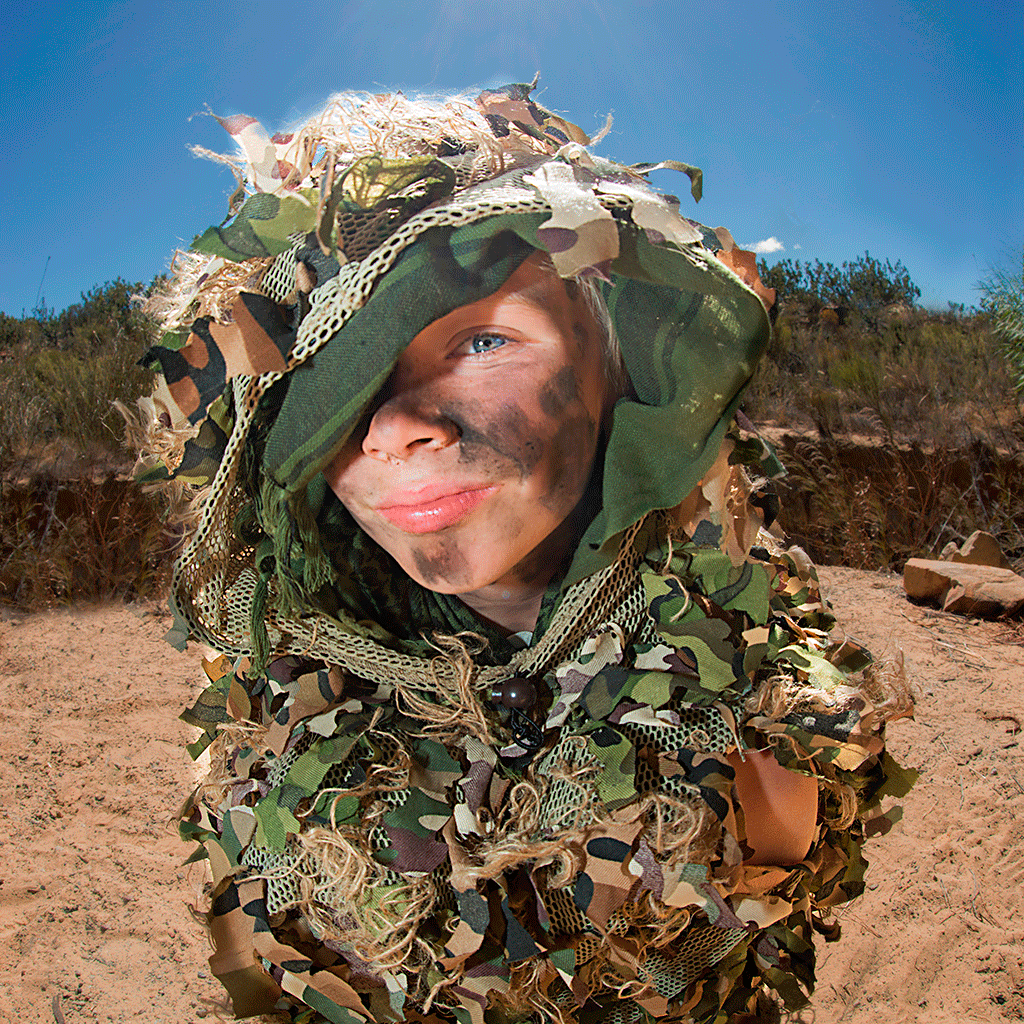
When hunting for dinner, camouflage goes a long way towards securing the next meal.
Some were for small animals such as mice and guinea fowl, others for larger fare such as antelope, warthogs or zombies. Of course, being in a nature reserve, we were not permitted to actually use our traps (nor would we have wanted to) but the knowledge learnt might one day help us survive.
We then did some spoor tracking exercises in the bush, learning how to follow animal footprints and how to identify the paths along which they regularly travel.
‘You need to know your prey’s routes before you can set a successful ambush or trap,’ said Marcus.

Spin spin spin. Rub rub rub. Eventually your arm will fall off, or you’ll make a fire.
Real trackers master their skills over years of study and practise but we at least picked up some basic techniques such as following spoor to a water source and getting to know what species were in the neighbourhood, and thus on the menu.
‘Here are some rats I caught and skinned earlier,’ I announced to the kids, showing them our bush- made wooden bowl, now filled with gross looking skilpadjies. ‘But how will we cook them?’
‘We don’t,’ cried my son in alarm.
‘We go back to Steers!’
But this time I was having none of it. Neither of my kids had seen a skilpadjie before… mwahahaha!

Learning to identify animals by their spoor is an intregal part of survival craft.
‘So let’s learn how to make a fire,’ chirped Marcus. It was a task that turned out to be far harder than you might have expected. We gathered tinder from the inside of dry proteas and made sparks with flints in an attempt to create an ember… but to no avail. We directed sunlight using a piece of broken glass, we did the stick-rubbed-between-hands method and we even used a homemade bow using string to spin a wooden drill.
We did manage to produce a wisp of smoke, but no matter how vigorously I rubbed, or how much I strained – sweat pouring and veins popping from my forehead – I was unable to get a fire going. The Kalahari bushmen make it look so simple. But it’s not. Eventually I had to admit defeat and resort to using a lighter.
‘Spirits up,’ said Marcus. ‘You won’t master everything in just a single weekend.’
Eventually, after several additional survival tasks and lessons, we were guided to a clifftop cave with the most amazing view out over the reserve. ‘This is your home for the evening,’ said Marcus, and with that, he left us there to our own devices.
Using the skills we had learnt over the previous days, we set about building the final C (cover) using shrubbery and brush knotted onto a frame made of sticks.

A clan of survivalists gathered around a campfire, taking it in turns to make tea and keep the hordes of zombies at bay.
We used homemade string cut with flakes of flint, and we made fire using a smoldering piece of coal wrapped tightly in green moss and carried from our previous blaze. We even put up little trip wires on the trail leading to our cave, just in case of zombies or aliens… or SARS.
And so there we sat, my ‘New Dawn’ family, peering up at a sky full of stars above an empty Karoo landscape, ‘rat’ fat dribbling down our chins, and feeling ready to survive the coming apocalypse, no matter what guise it might take.
And that’s when we spotted the meteor. Oh well! There’s only so much you can do to prepare for the end of the world.
Do It
Rangers Reserve self-catering weekend bushcraft and survival courses start at R1 000 per person, including basic accommodation in a tented camp.
Course content is tailored to the interests and needs of the group dependent on age and experience of the participants. Longer, more intense workshops can be arranged by contacting the operators.
There are various options to upgrade accommodation to a farmhouse and cottages ranging in price from R950 per night for a two-sleeper, R1 850 per night for an eight-bed house and R3 000 per night for a luxury home (sleeps four).
023 004 0074 | rangersreserve.co.za
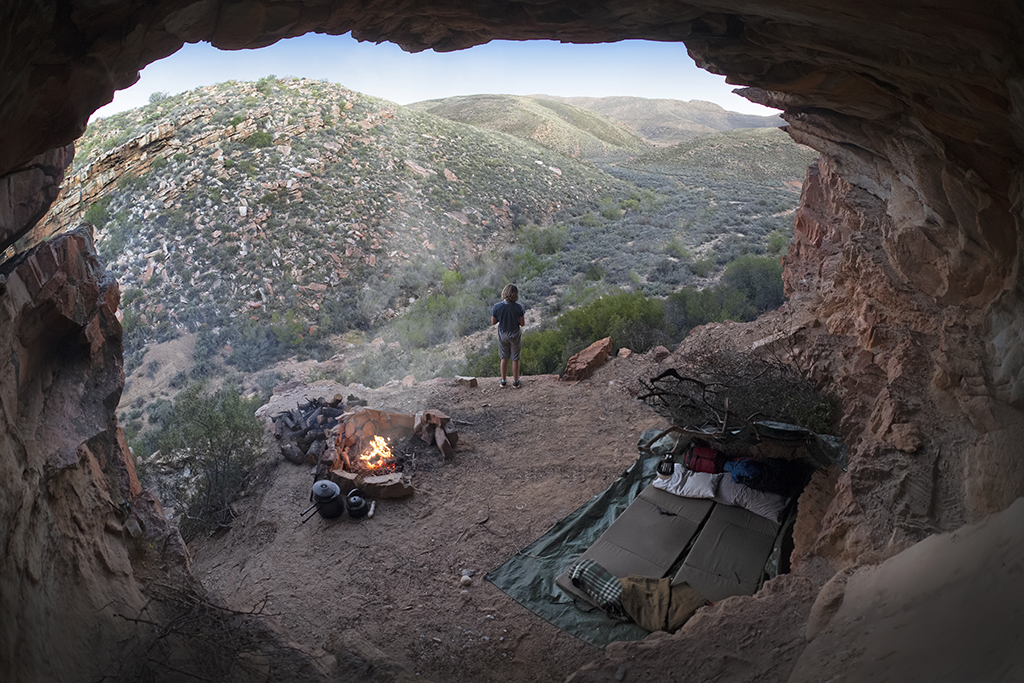
Home sweet home. A fire, a meal, and a roof over your head. What more could you need?
There are several survival craft course operators in South Africa
Boswa Survival
Gauteng branch:
Hartebeestfontein
072 916 5080
Limpopo branch:
Warmbad, Bela Bela
082 094 2262
Mpumalanga branch:
Schoemanskloof
073 861 1246
boswa.co.za
Wilderness Trails
KZN iMfolozi Wilderness
083 225 5960
wildernesstrails.org.za
SA Special Forces Association offers hardcore survival and bespoke family courses in Gauteng
012 663 2211, recce.co.za
Gwahumbe Reserve offers junior ranger camps in KZN
082 347 6536
gwahumbe.co.za









